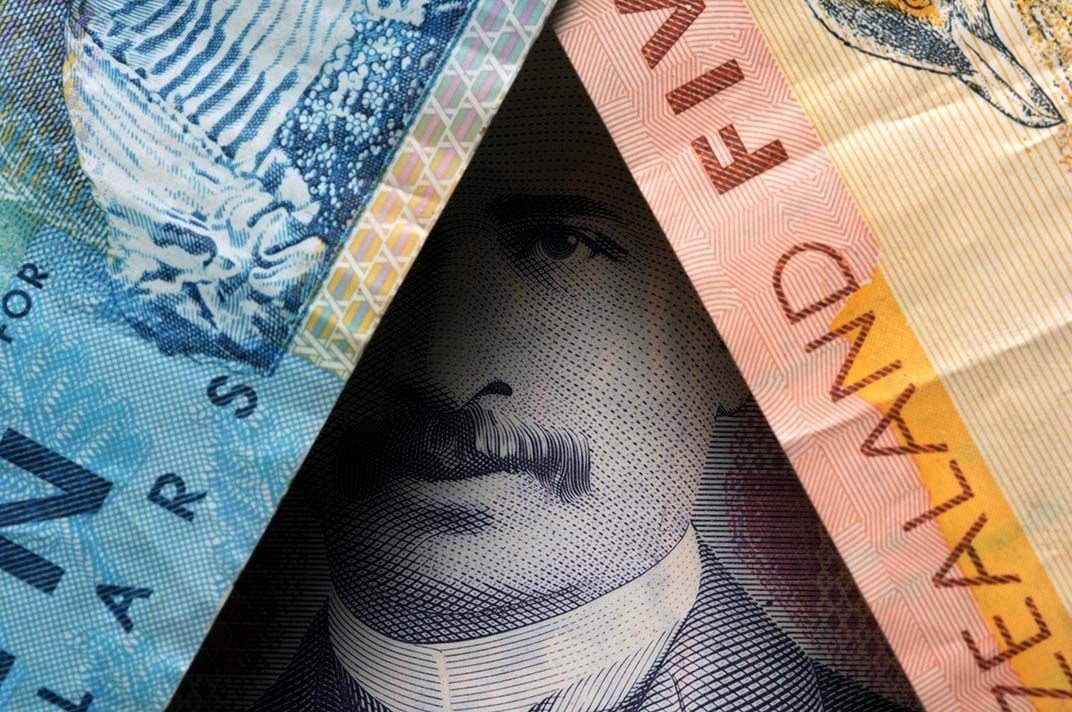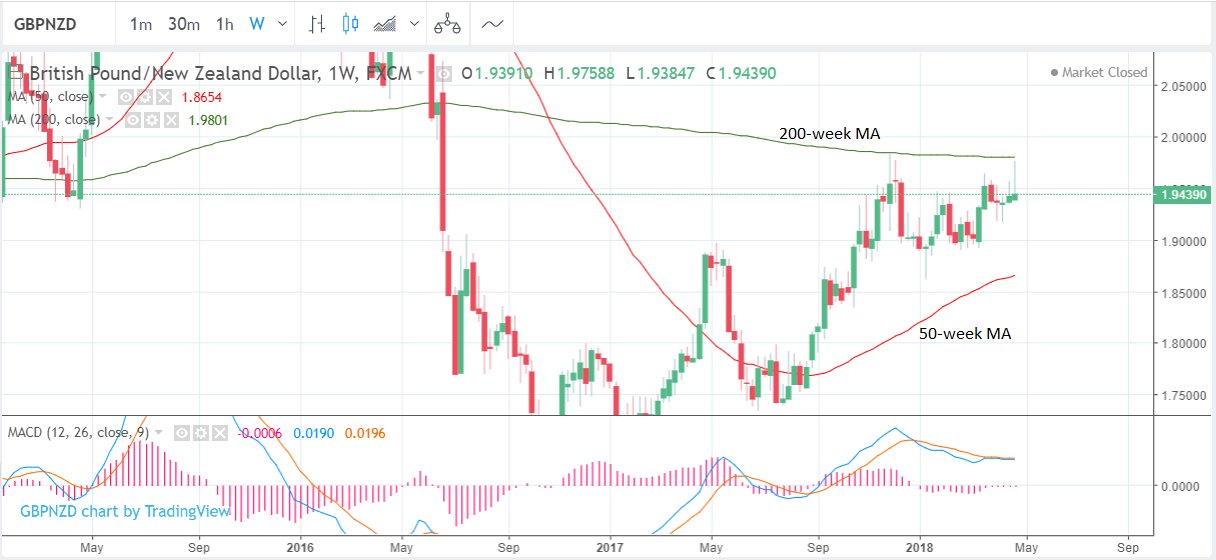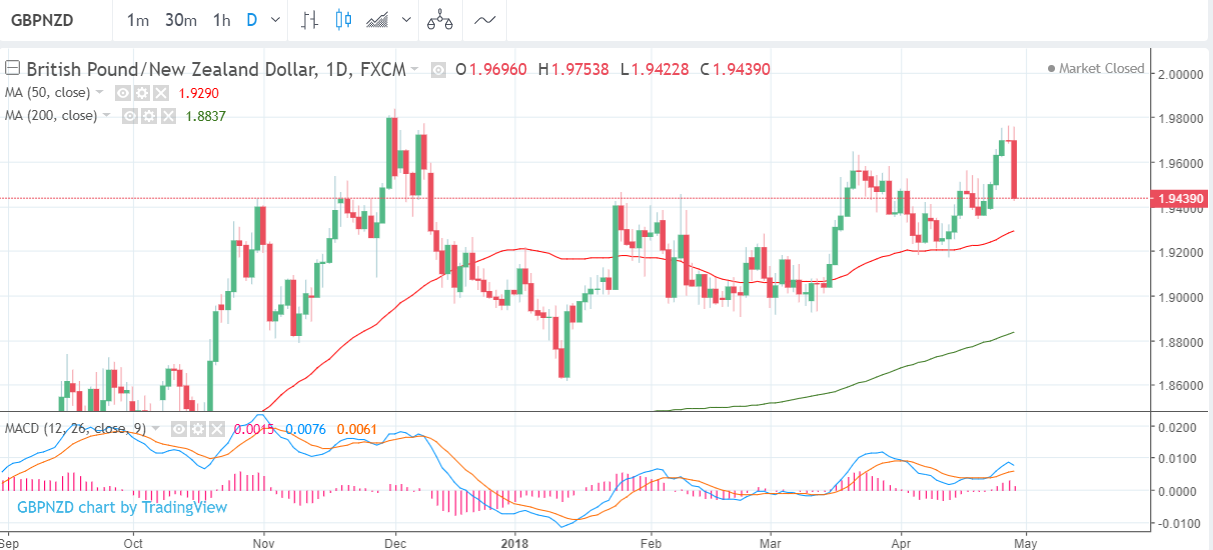The Pound-to-New Zealand Dollar Rate's Forecast For the Week Ahead
- GBP/NZD remains trapped in a sideways range below overarching resistance in the 1.98s
- The main release for the Pound in the week ahead is PMI data
- The New Zealand Dollar could see movement from the latest fix of the Dairy Price Index and employment data

© Comugnero Silvana, Adobe Stock
One Pound buys 1.9439 New Zealand Dollars (Kiwis) at the time of writing, little changed from the previous trading week.
The GBP/NZD pair continues trading more or less in a sideways range below its former highs in the 1.98s.
Upside is likely to be hard going above 1.98 because of the 200-week moving average (MA) which is situated at 1.9803.
As can be seen from the picture of the weekly chart above the 200-week MA has successfully capped the highs and the exchange rate has been unable to break above it.
Uptrending prices often stall, pull-back or even sometimes reverse at the level of large moving averages like the 200-week, because they are used by large speculators, fund managers and retail traders alike as a decision-making tool, and are therefore subject to greater-than-average levels of liquidity.
The pair may even reverse the trend from the 200-week and start falling.
Another obstacle to the further upside is the 2.000 exchange rate level which is a major round-number and therefore subject to increased amounts of buying and selling in its vicinity. This is because it is more likely to be singled out as a level at which traders will decide to take profit.
Previously we thought the daily chart of GBP/NZD was showing a breakout from a triangle pattern, however, we are not as certain now that the pattern was a bona fide triangle as there was no volatile breakout as would be expected, and the pair continues moving within the range outlined above.
The longer-term trend is technically still bullish but the because of the 200-week MA capping gains above 1.98 and the range-bound daily activity we have decided to desist from making a forecast for the pair in the week ahead as both further upside or downside are possible.
Get up to 5% more foreign exchange by using a specialist provider to get closer to the real market rate and avoid the gaping spreads charged by your bank when providing currency. Learn more here.
Data and Events to Watch for the New Zealand Dollar
The first major release for the New Zealand Dollar in the week ahead is the Global Dairy Trade Auction Price Index (GDT) which fixes the price of a basket of dairy products sold at a global fortnightly auction.
One of the products auctioned is dried whole milk which is New Zealand's biggest commodity. This means the GDT auction can impact on the New Zealand Dollar with th currency strengthening if the GDT Index rises unexpectedly and vice versa for a fall.
The Index covers a basket of dairy products including cheese, butter, dried skimmed milk, rennet casein, lactose and anhydrous milk fat.
Two weeks ago the index showed a 2.7% rise, reversing a string of previously negative results - more details of the index and past prices are available from the GDT website here.
The auction is on Tuesday, May 1 at 15.40 GMT.
The other main release for the Kiwi in the week ahead is employment data, out at 23.45 on Tuesday, May 1.
The data is forecast to show unemployment slightly lower at 4.4% in Q1, from 4.5% in the previous quarter.
"While business confidence may be struggling, the demand for skilled and unskilled labour continues to outstrip supply, and hence we expect another decent lift in employment, lowering the unemployment rate to 4.3% (mkt 4.4%)," says Canadian investment bank TD Securities in their week ahead preview, adding, "We look for wages growth to be solid at +0.5%/q, or 2.0%/y, but don't expect the minimum-wage-led jump until Q2 (we pencil in +0.8%/q and 2.4%/y)."
Data and Events to Watch for the Pound
The main data release for the Pound in the week ahead will be the release of April Service and Manufacturing PMIs out at 9.30 on Thursday and Tuesday respectively.
PMI is short for Purchasing Manager Index, and PMIs are survey-based indicators which are seen as useful forward-indicators of economic activity.
The market consensus appears to be for expecting a rebound in Services in April after the drop in March, which was put down, mainly to bad weather. Services PMI in April is expected to rise to 53.5 from 51.7 and Manufacturing to 54.8 from 55.1.
The Pound may be especially sensitive to the results this week owing to the lazer-like focus currency markets are currently placing on UK economic data.
Sterling fell by over a percent against both the Euro and US Dollar in the wake of economic growth data which revealed the UK economy grew a mere 0.1% in the first three months of 2018, growth that has virtually killed any prospect of an interest rate rise being delivered by the Bank of England in May.
Will the incoming data surveys point to a pick-up in activity, or will they suggest the economic slowdown is more entrenched?
From the market expecting a hike with almost 100% certainty a few weeks ago, the probabilities have now fallen to circa 50% after comments from the governor of the BoE suggested there might be a delay owing to the downturn in data.
The possibility of a delay in raising rates led to a drop in the Pound which is highly sensitive to interest rate expectations.
Expectations of higher rates tends to lift the Pound and vice versa for the lower rates. This is because higher rates tend to attract greater inflows of foreign capital drawn by the promise of higher returns and this increases demand for the Pound.
"We may see an outsized market reaction from any surprises, as they tilt markets toward or away from a May BoE hike," says Canadian investment bank TD Securities in their note on the week ahead.
The bullish market forecasts for Manufacturing are not shared by some, including Philip Shaw, an analyst at Investec, who sees risks to April's figure both from the sharp appreciation in the Pound and the heightened talk of a trade war in early April.
Shaw does, however, share the market's more upbeat forecast for Services, which he expects to rebound by three points to 54.7 due to the temporary impact of bad weather dissipating.
More generally the lack of market-moving data besides PMIs means the weak could be a slow one for the Pound.
"Domestically, next week may represent a lull before the storm provided by the 10 May Bank of England Inflation Report and MPC announcement," says Shaw. "Bearing in mind Mark Carney’s comments last week about mixed data, the decision may be more finely balanced than we had envisaged."
"But we judge that the MPC will believe that the tight labour market will override the softer than expected short-term inflation environment," concludes the analyst.
The other major event in the week ahead for the Pound is the UK local elections on Thursday, May 3 at 1.00 GMT.
The main way it could impact is via Brexit expectations, such as for example if there is a surprise outsized vote for the anti-Brexit liberal democrats, which might be Sterling positive.
If the Conservatives win a larger-than-expected majority it could impact on Sterling in two ways depending on how investors interpret the result.
It could be negative for Sterling because the Conservative party is probably the party most in favour of the 'harder' forms of Brexit.
At the same time is could be positive for the Pound if it is interpreted as showing increased confidence in Theresa May's leadership, suggesting a reduction in the influence of the far right within the party, and therefore more likely to deliver a pragmatic rather than ideologically driven Brexit solution.
A Labour landslide would be negative for Sterling, according to TD Securities.
"While polls have consistently been pointing toward big Labour wins/Conservative losses at next week's local elections, with GBP being vulnerable to political developments, we may see a negative market reaction to any "Labour landslide" headlines. Vote counting only begins on Friday, so results should trickle out later that day," say TD Securities.
It is not unusual for voters to use the local elections to express dissatisfaction with the reigning government so a labour victory would not be particularly surprising or necessarily especially indicative of future voting patterns.
Get up to 5% more foreign exchange by using a specialist provider to get closer to the real market rate and avoid the gaping spreads charged by your bank when providing currency. Learn more here.






